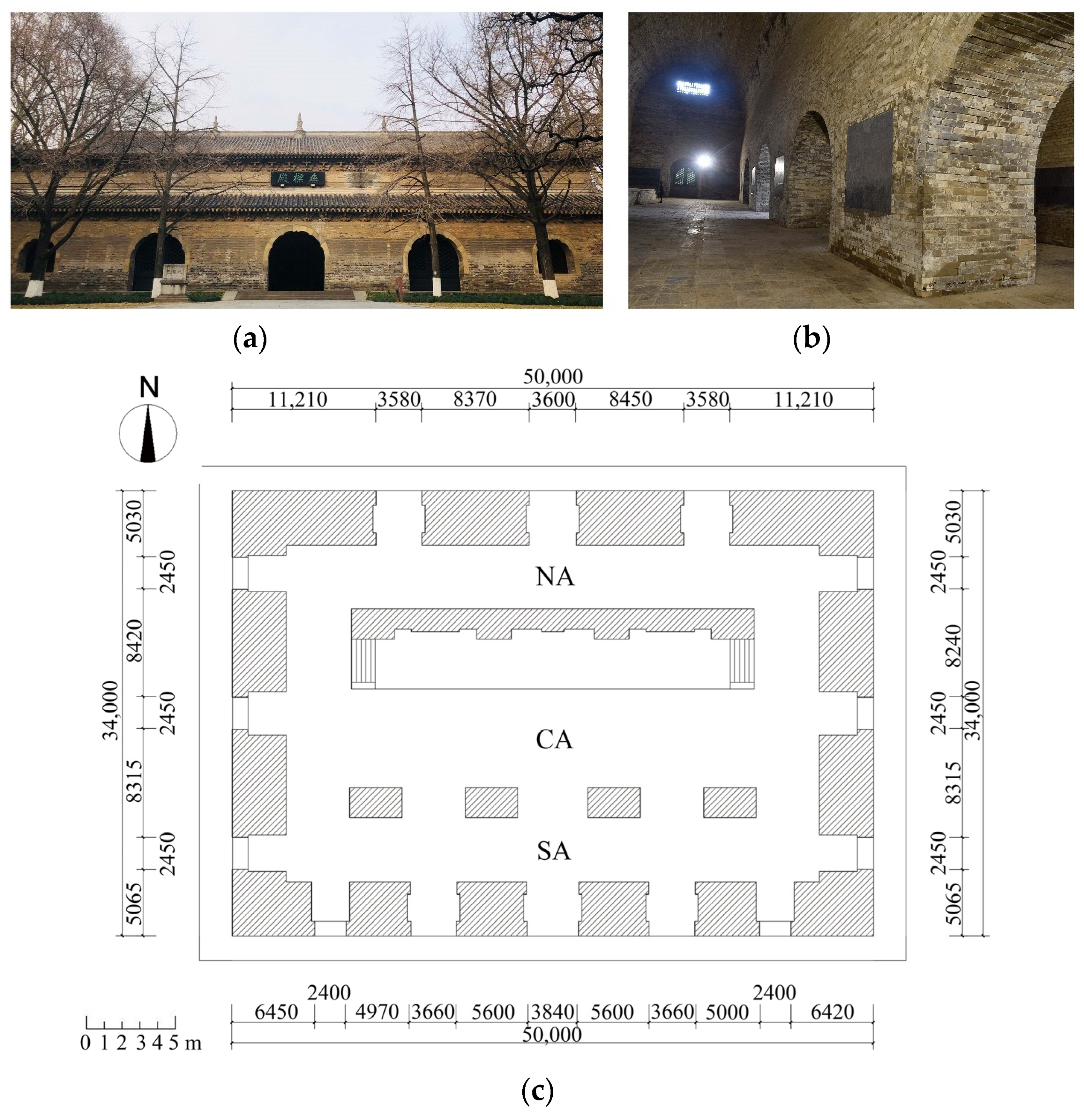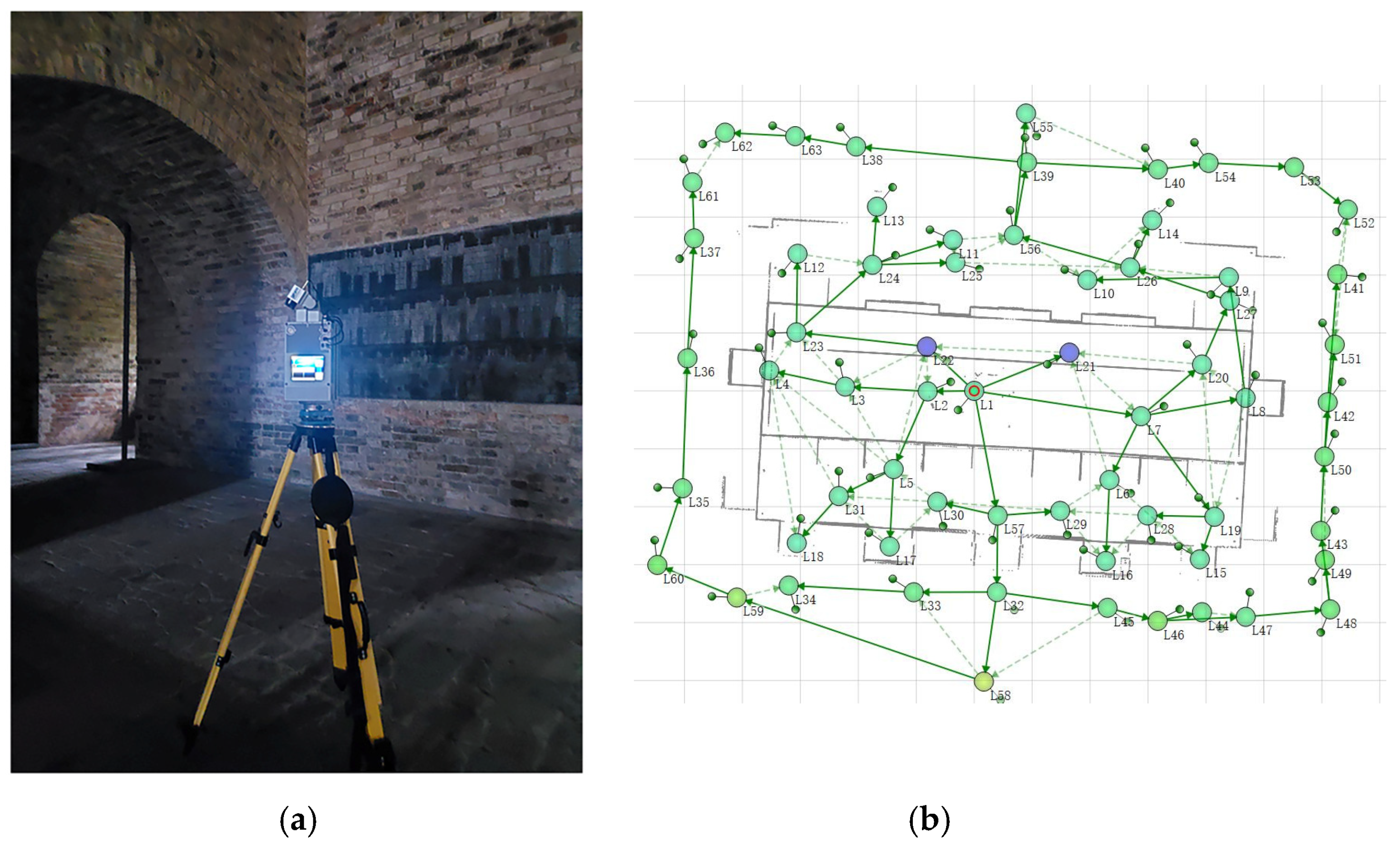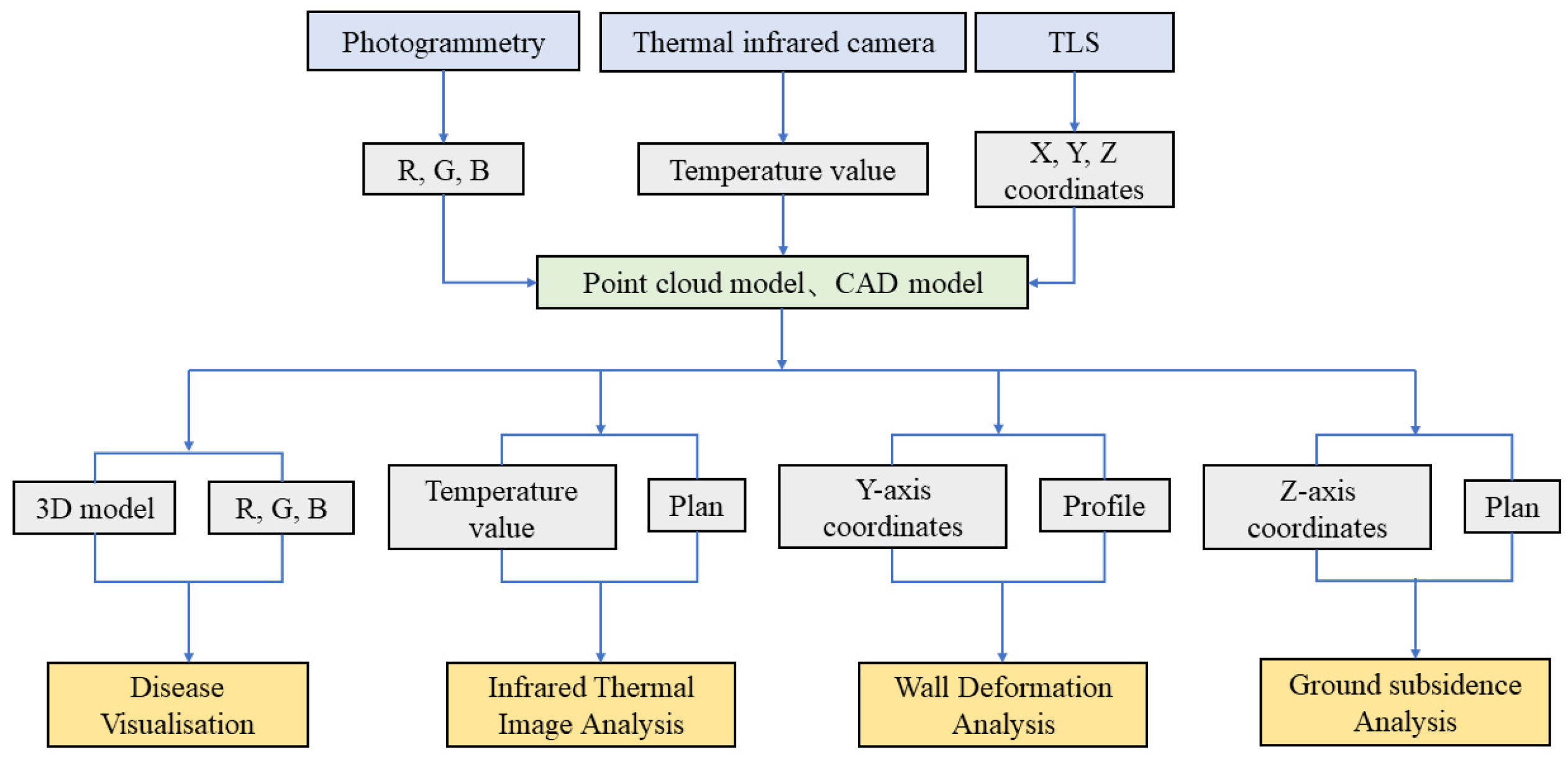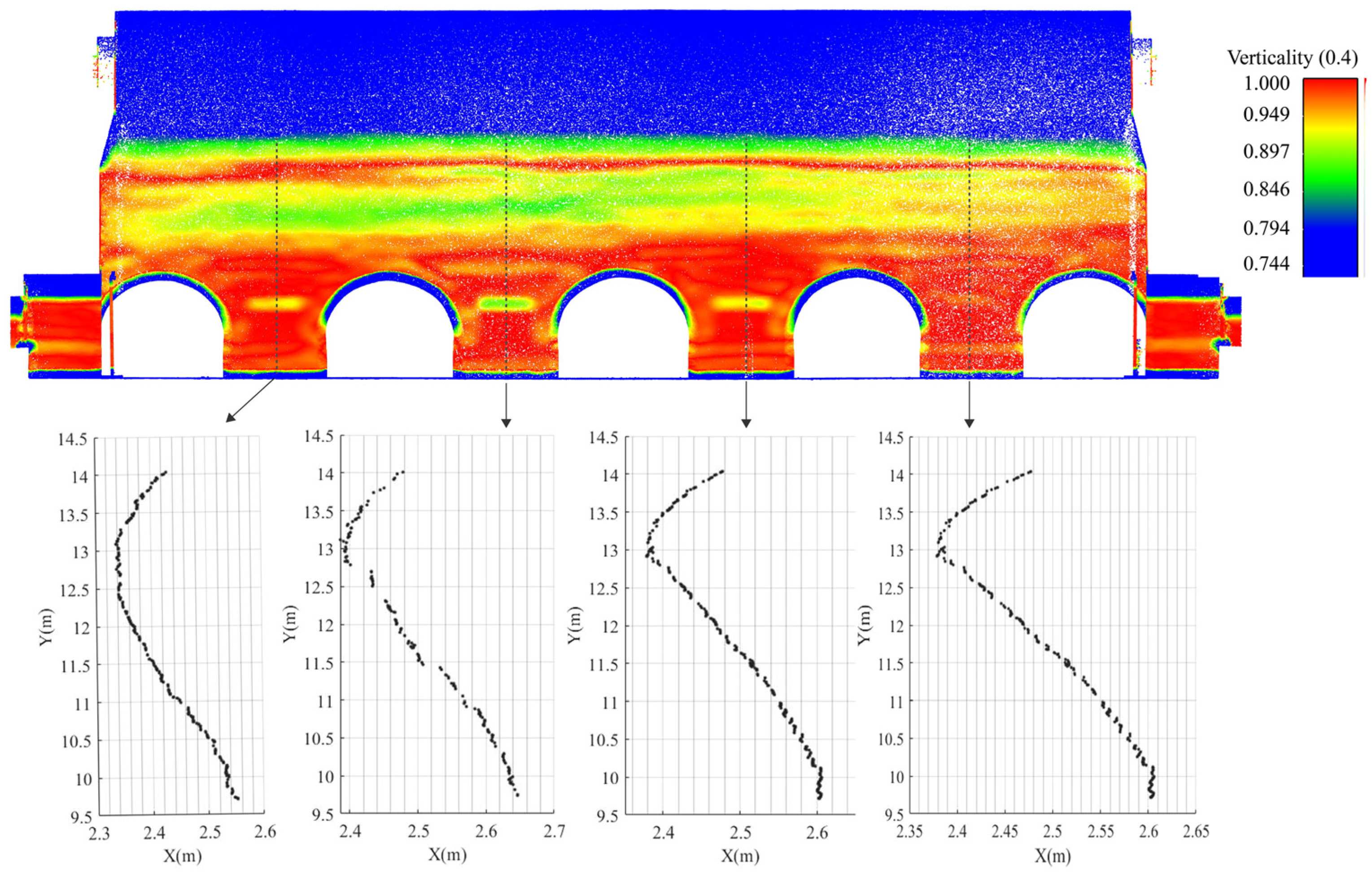High-Definition Survey of Architectural Heritage Fusing Multisensors—The Case of Beamless Hall at Linggu Temple in Nanjing, China
Abstract
:1. Introduction
Research Aim
2. Related Works
2.1. Point-Cloud Processing
2.2. Representation with Computer Graphics
2.3. Level of Detail
2.4. Summary
3. Data Collection
3.1. Description of the Beamless Hall at Linggu Temple
3.2. Measurement Techniques Used
3.2.1. 3D Laser Scanning
3.2.2. Photogrammetry
- Align photos: default (accuracy: medium; key point limit: 40,000, tie point limit: 4000).
- Build dense cloud: default (quality: medium).
- Build mesh: default (quality: medium; face count: medium).
- Build texture: default (texture type: diffuse map; mapping mode: generic).
- Build orthomosaic: default (type: planar; surface: mesh).
3.2.3. Infrared Thermal Image
4. Graphical Representation of Architectural Pathologies
4.1. Ground Subsidence Analysis
- (a)
- The most obvious uneven subsidence of the ground of the Beamless Hall is in the middle ground of the north arch (NA) and the section of the ground from the south arch (SA) into the central arch (CA); the difference between the two subsidence distances is approximately 8 cm.
- (b)
- There is an obvious ground subsidence at the three entrances of the SA and NA, and the value of ground subsidence at the entrance is approximately 5 cm compared with the average height of the interior floor of the Beamless Hall.
4.2. Wall Deformation Analysis
- (a)
- The verticality calculation of the six walls showed that the south wall suffered more extensive deformations than the north wall;
- (b)
- An S-shape distortion was observed at the south wall under CA (Figure 5). It is probably owing to the interacted thrust between SA and CA. The former thrust led to a lateral displacement (ca. 10 cm) around the springing of SA, and the latter led to a reverse displacement (ca. 15 cm) around the springing of CA.
4.3. Infrared Thermal Image Analysis
- The overall temperature range of the NA was between 15.5 °C and 18 °C.
- Moisture was prevalent in the top of the arch of the NA with the most severe part of the arch located on the north side of the west arch top of the NA.
4.4. Visualisation of Deterioration
5. Discussion
6. Conclusions
- (a)
- Architectural heritage surveying and mapping is an important approach that allows intervention in heritage conservation. The advantage of architecture involves the interpretation of the surveyed object from the perspective of architectural discipline, while the replacement of measuring tools should not be a factor that would affect the dominant position of architectures in this field.
- (b)
- The ground subsidence diagram, wall deformation analysis diagram, and moisture distribution analysis diagram can reflect visually the situation and extent of destruction that the building is suffering from and provide guidance for the subsequent conservation decision stage.
- (c)
- The subsequent step is to establish the current situation model based on the point-cloud model, after which the information of graphics and images are integrated with the 3D model in the BIM platform aiming at creating a systematic and intuitive data management strategy. On this basis, visual interaction is provided for data users (heritage manager, experts, and visitors).
Author Contributions
Funding
Institutional Review Board Statement
Informed Consent Statement
Data Availability Statement
Acknowledgments
Conflicts of Interest
References
- Li, J. Study on the History of Chinese Architectural Heritage Surveying and Mapping. Ph.D. Thesis, Tianjin University, Tianjin, China, 2015. [Google Scholar]
- Wang, Q.H.; Wu, C.; Bai, C.J. Mapping of Ancient Buildings, 1st ed.; Architecture & Building Press: Beijing, China, 2006; p. 52. [Google Scholar]
- Hou, W.D. An outline of ancient Chinese masonry buildings and their protection and restoration. China Cult. Herit. Sci. Res. 2012, 2, 50–53. [Google Scholar]
- Riveiro, B.; Morer, P.; Arias, P.; de Arteaga, I. Terrestrial laser scanning and limit analysis of masonry arch bridges. Constr. Build. Mater. 2011, 25, 1726–1735. [Google Scholar] [CrossRef]
- Zhou, W.Q.; Zhou, P.; Wang, Y.J. Masonry artifacts disease and classification overview. Relics Mus. 2014, 6, 73–75. [Google Scholar]
- Pepe, M.; Costantino, D.; Garofalo, A.R. An efficient pipeline to obtain 3D model for HBIM and structural analysis purposes from 3D point clouds. Appl. Sci. 2020, 10, 1235. [Google Scholar] [CrossRef] [Green Version]
- Banfi, F.; Fai, S.; Brumana, R. BIM automation: Advanced modeling generative process for complex structures. In Proceedings of the 26th International CIPA Symposium on Digital Workflows for Heritage Conservation 2017, Ottawa, ON, Canada, 28 August–1 September 2017; pp. 9–16. [Google Scholar] [CrossRef] [Green Version]
- Pesci, A.; Bonali, E.; Galli, C.; Boschi, E. Laser scanning and digital imaging for the investigation of an ancient building: Palazzo d’Accursio study case (Bologna, Italy). J. Cult. Herit. 2012, 13, 215–220. [Google Scholar] [CrossRef]
- Costa-Jover, A.; Lluis i Ginovart, J.; Coll-Pla, S.; López Piquer, M. Using the terrestrial laser scanner and simple methodologies for geometrically assessing complex masonry vaults. J. Cult. Herit. 2019, 36, 247–254. [Google Scholar] [CrossRef]
- Kashani, A.G.; Olsen, M.J.; Parrish, C.E.; Wilson, N. A review of LiDAR radiometric processing: From ad hoc intensity correction to rigorous radiometric calibration. Sensors 2015, 15, 28099–28128. [Google Scholar] [CrossRef] [Green Version]
- Sanchez, L.J.; Del Pozo, S.; Ramos, L.; Arce, A.; Fernandes, F. Heritage site preservation with combined radiometric and geometric analysis of TLS data. Autom. Constr. 2018, 85, 24–39. [Google Scholar] [CrossRef]
- Del Pozo, S.; Herrero-Pascual, J.; Felipe-García, B.; Hernández-López, D.; Rodríguez-Gonzálvez, P.; Aguilera, S.D.P. Multispectral radiometric analysis of façades to detect pathologies from active and passive remote sensing. Remote Sens. 2016, 8, 80. [Google Scholar] [CrossRef] [Green Version]
- Tan, K.; Cheng, X. Correction of incidence angle and distance effects on TLS intensity data based on reference targets. Remote Sens. 2016, 8, 251. [Google Scholar] [CrossRef] [Green Version]
- Kaasalainen, S.; Jaakkola, A.; Kaasalainen, M.; Krooks, A.; Kukko, A. Analysis of incidence angle and distance effects on terrestrial laser scanner intensity: Search for correction methods. Remote Sens. 2011, 3, 2207–2221. [Google Scholar] [CrossRef] [Green Version]
- Krooks, A.; Kaasalainen, S.; Hakala, T.; Nevalainen, O. Correction of intensity incidence angle effect in terrestrial laser scanning. ISPRS Ann. Photogramm. Remote Sens. Spat. Inf. Sci. 2013, II-5/W2, 145–150. [Google Scholar] [CrossRef] [Green Version]
- Höfle, B.; Pfeifer, N. Correction of laser scanning intensity data: Data and model-driven approaches. ISPRS J. Photogramm. Remote Sens. 2007, 62, 415–433. [Google Scholar] [CrossRef]
- Wu, C. Beyond Projection: A Study of Architectural Graphology in Cultural Perspective; Tianjin University Press: Tianjin, China, 2004; ISBN 7-5618-1931-5. [Google Scholar]
- Li, L.J. Research on the Informatization of the Result Presentation of Architectural Heritage Survey. Master’s Thesis, Tianjin University, Tianjin, China, 2012. [Google Scholar]
- Chun, Q.; Yang, H.; Meng, Z.; Han, Y. Research on the architectural form and structural performance of the brick-vault hall of Yongzuo Temple. Sci. Conserv. Archaeol. 2019, 31, 85–91. [Google Scholar] [CrossRef]
- Giunta, G.; Di Paola, E.; Castiglione, B.M.V.; Menci, L. Integrated 3D-database for diagnostics and documentation of milan’s cathedral façade. In Proceedings of the CIPA 2005 XX International Symposium, Torino, Italy, 26 September–1 October 2005; Volume 3. [Google Scholar]
- Giammartini, B.B. Mapping of the stones in the main façade of St. Giuliana castle (Umbertide, Italy). Period. Mineral. 2010, 79, 11–20. [Google Scholar] [CrossRef]
- Lezzerini, M.; Antonelli, F.; Columbu, S.; Gadducci, R.; Marradi, A.; Miriello, D.; Parodi, L.; Secchiari, L.; Lazzeri, A. The documentation and conservation of the cultural heritage: 3D laser scanning and GIS techniques for thematic mapping of the stonework of the Façade of St. Nicholas Church (Pisa, Italy). Int. J. Archit. Herit. Conserv. Anal. Restor. 2016, 10, 9–19. [Google Scholar] [CrossRef]
- Campanaro, D.M.; Landeschi, G.; Dell’Unto, N.; Touati, A.-M.L. 3D GIS for cultural heritage restoration: A ‘white box’workflow. J. Cult. Herit. 2016, 18, 321–332. [Google Scholar] [CrossRef]
- He, J.; Liu, J.; Xu, S.; Wu, C.; Zhang, J. A GIS-based cultural heritage study framework on continuous scales: A case study on 19th century military industrial heritage. Int. Arch. Photogramm. Remote Sens. Spat. Inf. Sci. 2015, 40, 215. [Google Scholar] [CrossRef] [Green Version]
- Siart, C.; Eitel, B.; Panagiotopoulos, D. Investigation of past archaeological landscapes using remote sensing and GIS: A multi-method case study from Mount Ida, Crete. J. Archaeol. Sci. 2008, 35, 2918–2926. [Google Scholar] [CrossRef]
- Alexakis, D.; Sarris, A.; Astaras, T.; Albanakis, K. Integrated GIS, remote sensing and geomorphologic approaches for the reconstruction of the landscape habitation of Thessaly during the neolithic period. J. Archaeol. Sci. 2011, 38, 89–100. [Google Scholar] [CrossRef]
- Hadjimitsis, D.; Agapiou, A.; Alexakis, D.; Sarris, A. Exploring natural and anthropogenic risk for cultural heritage in Cyprus using remote sensing and GIS. Int. J. Digit. Earth 2013, 6, 115–142. [Google Scholar] [CrossRef]
- Opitz, R.; Nowlin, J. Photogrammetric modelling + GIS: Better methods for working with mesh data. ArcUser Spring 2012, 2012, 46–49. [Google Scholar]
- De Reu, J.; Plets, G.; Verhoeven, G.; De Smedt, P.; Bats, M.; Cherretté, B.; De Maeyer, W.; Deconynck, J.; Herremans, D.; Laloo, P.; et al. Towards a three-dimensional cost-effective registration of the archaeological heritage. J. Archaeol. Sci. 2013, 40, 1108–1121. [Google Scholar] [CrossRef]
- Wheatley, D.; Gillings, M. Spatial Technology and Archaeology: The Archaeological Applications of GIS, 1st ed.; CRC Press: Boca Raton, FL, USA, 2013. [Google Scholar]
- Conolly, J.; Lake, M. Geographical Information Systems in Archaeology; Cambridge University Press: London, UK, 2006. [Google Scholar]
- Simeone, D.; Cursi, S.; Acierno, M. BIM semantic-enrichment for built heritage representation. Autom. Constr. 2019, 97, 122–137. [Google Scholar] [CrossRef] [Green Version]
- Bruno, N.; Roncella, R. A restoration oriented HBIM system for cultural heritage documentation: The case study of Parma Cathedral. Int. Arch. Photogramm. Remote Sens. Spat. Inf. Sci. 2018, XLII-2, 171–178. [Google Scholar] [CrossRef] [Green Version]
- Godinho, M.; Machete, R.; Ponte, M.; Falcão, A.P.; Gonçalves, A.; Bento, R. BIM as a resource in heritage management: An application for the National Palace of Sintra, Portugal. J. Cult. Herit. 2020, 43, 153–162. [Google Scholar] [CrossRef]
- Fai, S.; Graham, K.; Duckworth, T.; Wood, N.; Attar, R. Building information modelling and heritage documentation. In Proceedings of the 23rd International Symposium, International Scientific Committee for Documentation of Cultural Heritage (CIPA), Prague, Czech, 11–16 September 2011; pp. 12–16. [Google Scholar]
- López, F.J.; Lerones, P.M.; Llamas, J.; Gómez-García-Bermejo, J.; Zalama, E. A review of heritage building information modeling (H-BIM). Multimodal Technol. Interact. 2018, 2, 21. [Google Scholar] [CrossRef] [Green Version]
- Logothetis, S.; Karachaliou, E.; Stylianidis, E. From OSS CAD to BIM for cultural heritage digital representation. Int. Arch. Photogramm. Remote Sens. Spat. Inf. Sci. 2017, 42, 439. [Google Scholar] [CrossRef] [Green Version]
- Bryan, P.; Blake, B.; Bedford, J.; Barber, D.; Mills, J. Metric Survey Specifications for Cultural Heritage; English Heritage: Swindon, UK, 2013; ISBN 978-1-84802-171-6. [Google Scholar]
- Brumana, R.; Della Torre, S.; Previtali, M.; Barazzetti, L.; Cantini, L.; Oreni, D.; Banfi, F. Generative HBIM modelling to embody complexity (LOD, LOG, LOA, LOI): Surveying, preservation, site intervention—the Basilica di Collemaggio (L’Aquila). Appl. Geomat. 2018, 10, 545–567. [Google Scholar] [CrossRef]
- Sun, Z.; Xie, J.; Zhang, Y.; Cao, Y. As-built BIM for a fifteenth-century Chinese brick structure at various LoDs. ISPRS Int. J. Geoinf. 2019, 8, 577. [Google Scholar] [CrossRef] [Green Version]
- Fang, J.W.; Sun, Z.; Zhang, Y.R. TLS-FEM integrated structural deformation analysis on the Beamless Hall at Nanjing, China. Int. Arch. Photogramm. Remote Sens. Spat. Inf. Sci. 2021, 46, 215–220. [Google Scholar] [CrossRef]
- Olsen, M.J.; Kuester, F.; Chang, B.J.; Hutchinson, T.C. Terrestrial laser scanning-based structural damage assessment. J. Comput. Civ. Eng. 2010, 24, 264–272. [Google Scholar] [CrossRef]
- Sun, Z.; Cao, Y.K.; Zhang, Y.Y. Applications and discussions of portable optical measurement technologies for document Tibetan architectural heritage. Huazhong Archit. 2019, 37, 123–126. [Google Scholar] [CrossRef]
- Dai, S.B.; Chen, Y.; Zhong, Y. Frontier technologies for the conservation and restoration of modern Chinese masonry buildings. China Cult. Herit. 2016, 01, 68–72. [Google Scholar]
- Guo, F.; Liu, S.G.; Zhu, P.S. Case analysis of building enclosure defects by infrared thermal imaging detection. Build. Sci. 2012, 28, 81–84. [Google Scholar] [CrossRef]
- Shi, D.P.; Wu, C.; Li, Z.J.; Pan, W. Research and progress of infrared imaging technology in the safety field. Infrared Technol. 2015, 37, 528–535. [Google Scholar]
- Girardeau-Montaut, D. Cloudcompare—Open Source Project. 2018. Available online: https://www.danielgm.net/cc/ (accessed on 26 July 2021).
- Wang, K.; Yan, B.G.; Zhang, H.Y.; Chen, Z.C. Infrared thermograph non-destructive evaluation technique and its application in construction engineering. Concrete 2015, 5, 154–157. [Google Scholar]
- Yuan, R.X.; Zhao, M. Application of infrared thermal image technology in non-destructive examination. J. Fuzhou Univ. 2005, S1, 203–207. [Google Scholar]
- Adamopoulos, E.; Volinia, M.; Girotto, M.; Rinaudo, F. Three-dimensional thermal mapping from IRT images for rapid architectural heritage NDT. Buildings 2020, 10, 187. [Google Scholar] [CrossRef]









| Parameter | Value |
|---|---|
| Resolution | 382 × 288 pixels |
| Infrared spectrum | 7.5–13 μm |
| Working temperature | 0–50 °C (32–122 °F) |
| Storage temperature | −20–60 °C (−4–140 °F) |
| Working range | >1.6 m (4.8 ft) |
| Temperature resolution | 4096 increments (12 Bit) |
| System accuracy/absolute temperature accuracy | 1 ± 2 °C |
| Serial Number | Name | Point-Cloud Information Used |
|---|---|---|
| 1 | Ground subsidence analysis | Z-axis coordinates |
| 2 | South wall deformation analysis of the central vault (CA) | verticality |
| 3 | Horizontal displacement analysis of the south wall of the CA | Y-axis coordinates |
| 4 | Moisture distribution analysis at the top of the north vault | Temperature value |
| 5 | Expression of results using digital measurement technology | Temperature value, verticality, intensity value, and RGB |
Publisher’s Note: MDPI stays neutral with regard to jurisdictional claims in published maps and institutional affiliations. |
© 2022 by the authors. Licensee MDPI, Basel, Switzerland. This article is an open access article distributed under the terms and conditions of the Creative Commons Attribution (CC BY) license (https://creativecommons.org/licenses/by/4.0/).
Share and Cite
Fang, J.; Zhang, Y.; Zhang, Y.; Guo, H.; Sun, Z. High-Definition Survey of Architectural Heritage Fusing Multisensors—The Case of Beamless Hall at Linggu Temple in Nanjing, China. Sensors 2022, 22, 3369. https://doi.org/10.3390/s22093369
Fang J, Zhang Y, Zhang Y, Guo H, Sun Z. High-Definition Survey of Architectural Heritage Fusing Multisensors—The Case of Beamless Hall at Linggu Temple in Nanjing, China. Sensors. 2022; 22(9):3369. https://doi.org/10.3390/s22093369
Chicago/Turabian StyleFang, Junwei, Yingying Zhang, Yiru Zhang, Huayu Guo, and Zheng Sun. 2022. "High-Definition Survey of Architectural Heritage Fusing Multisensors—The Case of Beamless Hall at Linggu Temple in Nanjing, China" Sensors 22, no. 9: 3369. https://doi.org/10.3390/s22093369
APA StyleFang, J., Zhang, Y., Zhang, Y., Guo, H., & Sun, Z. (2022). High-Definition Survey of Architectural Heritage Fusing Multisensors—The Case of Beamless Hall at Linggu Temple in Nanjing, China. Sensors, 22(9), 3369. https://doi.org/10.3390/s22093369






